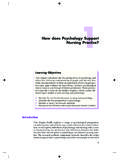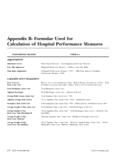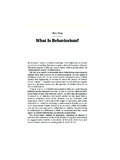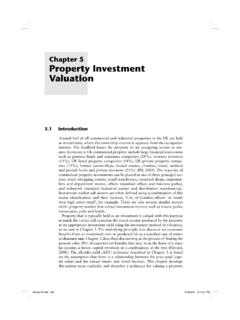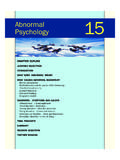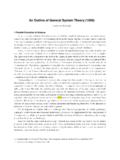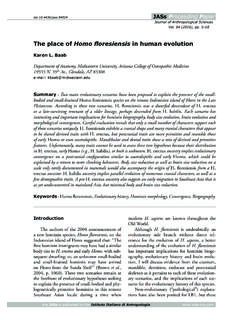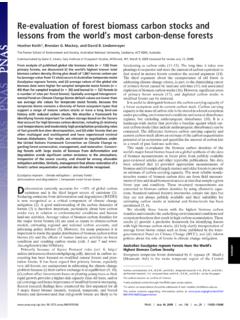Transcription of Part 1 Growth, Maturation, and Physical Performance
1 Part 1 growth , maturation , and Physical 22/8/07 11:21 AM Page 22/8/07 11:21 AM Page 2 growth refers to measurable changes in size, phys-ique and body composition, and various systems of the body, whereas maturation refers to progresstoward the mature state. maturation is variableamong bodily systems and also in timing and tempo of progress. The processes of growth andmaturation are related, and both influence physicalperformance. Chronologic age (CA) is the common reference instudies of growth and Performance . However, thereis considerable variation in growth , maturity, andperformance status among individuals of the sameCA, especially during the pubertal years. Interrelationships among growth , maturation , andperformance during childhood and adolescence arethe focus of this chapter. It specifically considers:1 Age-, sex-, and maturity-associated variation inphysical Performance ;2 growth and maturity characteristics of youngathletes;3 The influence of training on growth and matura-tion; and4 Matching of opponents for of growth and performanceSomatic growthGrowth in stature is rapid in infancy and earlychildhood, rather steady during middle childhood,rapid during the adolescent spurt, and then slow as adult stature is attained.
2 This pattern of growth (size-attained and rate) is generally similar for bodyweight and other dimensions with the exception ofsubcutaneous fat and fat distribution. The growthrate of stature is highest during the first year of lifethen gradually declines until the onset (take-off ) ofthe adolescent growth spurt (about 10 years in girlsand 12 years in boys). With the spurt, growth rateincreases, reaching a peak (peak height velocity,PHV) at about 12 years in girls and 14 years in boys,and then gradually declines and eventually ceaseswith the attainment of adult stature (Tanner 1962,1978; Malina et al. 2004). There is evidence for asmall mid- growth spurt in childhood in stature andprobably in other dimensions in many, but not all,children (Malina et al. 2004; see Chapter 31). Daily,half-weekly, or weekly measurements of length andheight indicate that growth is episodic rather thancontinuous over short periods (Lampl et al.)
3 1992),although mini growth spurts superimposed on acontinuous growth pattern have been suggested(Hermanussen et al. 1988). Physical performancePhysical Performance is commonly measured as the outcome (product) of standardized motor tasksrequiring speed, agility, balance, flexibility, explos-ive strength, local muscular endurance, and staticmuscular strength. Isometric strength increases linearly with ageduring childhood and the transition into adoles-cence in both sexes. At approximately 13 years,strength development accelerates considerably inboys (adolescent spurt), but continues to increaselinearly in girls through about 15 years with less evidence for a clear adolescent spurt, although dataChapter 1 growth and Biologic maturation : Relevance toAthletic PerformanceGASTON BEUNEN AND ROBERT M. 22/8/07 11:21 AM Page 34chapter1vary among specific strength tests.
4 Sex differencesin strength are consistent, although small, throughchildhood and the transition into adolescence. There-after, the differences become increasingly larger sothat at the age of 16 years and later only a few girlsperform at the same level as the average boy. AmongBelgian youth, for example, the median arm pullstrength of 17-year-old girls falls below the corres-ponding third percentile for boys (Beunen et al. 1989).Strength is related to body size and muscle mass, so that sex differences might relate to a size advant-age in boys. During childhood and adolescenceboys tend to have greater strength per unit bodysize, especially in the upper body and trunk thangirls, but corresponding sex differences in lowerextremity strength are negligible. In fact, isometricstrength in boys and girls increases during child-hood and adolescence more than predicted fromheight alone (Asmussen & Heeboll-Nielsen 1955).
5 Thedisproportionate strength increase is most apparentduring male adolescence, and is greater in the upperextremities than in the trunk or lower extremities(Asmussen 1962; Carron & Bailey 1974). Performance in a variety of standardized testssuch as dashes (speed), shuttle runs (agility, speed),vertical and standing long jumps and distancethrow (coordination and explosive strength), flexedarm hang and sit-ups (local muscular endurance),and beam walk and flamingo stand (balance) alsoimprove, on average, from childhood through ado-lescence in boys. The performances in girls increaseuntil the age of 13 14 years, with little subsequentimprovement, although some more recent evidencesuggests that the plateau for some motor tasks hasshifted to a slightly older age. The growth patternfor flexibility differs. Mean scores in the sit and reachare stable or decline slightly during childhood,increase during adolescence, and reach a plateau atabout 14 15 years in girls and decline from child-hood through mid-adolescence and then increase in boys (Haubenstricker & Seefeldt 1986; Beunen &Simons 1990; Malina et al.)
6 2004). Performances of girls fall, on average, within 1standard deviation (SD) below average performancesof boys in late childhood and early adolescence, withthe exception of softball throw for distance. However,after 14 years average performances of girls are consistently beyond the bounds of 1 SD below themeans of boys in most tasks. In contrast, girls aremore flexible than boys at virtually all ages (Beunenet al. 1989; Malina et al. 2004). Correlations between somatic dimensions andperformance in motor tasks during childhood aregenerally low (0 to about ). Performance in tasksin which the body is projected (jumps and dashes)correlates negatively and Performance in tasks inwhich an object is projected (throws) correlates positively with body mass. Correlations duringadolescence are of the same magnitude and in thesame direction as during childhood (Malina 1975;Malina et al.
7 2004).Most fitness test batteries include a direct or indirect estimate of aerobic power. Absolute aerobicpower (Vo2max, L min 1) increases from childhoodthrough adolescence in boys, but reaches a plateauat 13 14 years of age in girls. Before the age of 10 12 years, Vo2maxof girls reaches about 85 90% of the mean values of boys, but after the adolescentspurt average Vo2maxin girls reaches only 70% ofmean scores in boys (Krahenbuhl et al. 1985; Arms-trong & Welsman 1994; Malina et al. 2004). The dependence of aerobic power on body size during growth is indicated in the growth curve of relative aerobic power ( , per unit body mass, mL kg 1 min 1). The values are rather stablethroughout the growth period in cross-sectionalsamples of boys (Krahenbuhl et al. 1985), but trendsin longitudinal samples suggest a decline throughadolescence (Mirwald & Bailey 1986).
8 On the otherhand, relative Vo2maxdecreases systematically withage in girls (Krahenbuhl et al. 1985; Mirwald &Bailey 1986; Armstrong & Welsman 1994). Sex differ-ences in relative Vo2maxare generally smaller than in absolute Vo2max, with girls reaching 80 95% ofboys values. Several authors demonstrated thatexpressing Vo2maxto body mass may confound theunderstanding of changes in oxygen uptake withgrowth and maturation (see Chapter 5). Power func-tions, allometric equations, and multilevel model-ing have been used more recently. Results are mixedbecause of the various techniques used, the ageranges considered, and sample bias (Armstrong &Welsman 1994). When size and mass are included inthe scaling, mass exponents close to the 22/8/07 11:21 AM Page 4growth and performance5scaling coefficient of k= are obtained (Arsmtrong& Welsman 1994).
9 Adolescent spurts in performanceMost data for Performance are derived from cross-sectional samples which are inadequate forquantifying the timing and tempo of the adolescentgrowthspurt. Individuals pass through adolescenceat their own pace and consequently have their growthspurts over a wide range of CAs, the so-called time-spreading effect (Tanner 1962). Only longitudinal ormixed longitudinal data properly analysed provideadequate information about tempo and timing ofspurts in a variety of addition to documenting the occurrence ofgrowth spurts per se in Performance , the timing ofthe spurts is ordinarily viewed relative to the tim-ing of PHV ( , relative to a biologic milestone)rather than to CA. This serves to reduce the timespread along the CA axis and provides more spe-cific information about the timing and magnitude of adolescent spurts in other body dimensions thanheight and in Performance .
10 Note that this conceptwas first realized by Boas (1892). In such analyses, individual velocities for a bodydimension or Performance item are aligned on theindividual s PHV so that growth rates are viewed in terms of years before and after the individual sPHV, regardless of the age at which PHV mean constant velocity curve is obtained fromthese individual values in which the aligned indi-vidual values are combined. When mathematicalfunctions are used, the mean constant curve isobtained by fitting the function to each individual,estimating the constants for each individual, andthen averaging the constants to yield the curve. Longitudinal data show well-defined adolescentspurts in strength, several motor performances, andabsolute aerobic power of boys. Corresponding datafor girls are less extensive and show a spurt in absoluteaerobic power while data for strength are male adolescent spurt in static strength occursabout year after PHV and is more coincidentwith peak weight velocity (PWV) (Stolz & Stolz1951; Carron & Bailey 1974; Kemper & Verschuur1985; Beunen et al.)




